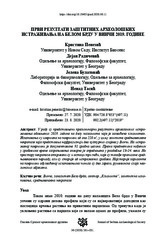Prikaz osnovnih podataka o dokumentu
Prvi rezultati zaštitnih arheoloških istraživanja na Belom brdu u Vinči 2019. godine
First results of rescue archaeological excavations at the site of Belo brdo in Vinča in 2019
| dc.creator | Penezić, Kristina | |
| dc.creator | Radičević, Dejan | |
| dc.creator | Bulatović, Jelena | |
| dc.creator | Tasić, Nenad | |
| dc.date.accessioned | 2021-10-12T13:12:26Z | |
| dc.date.available | 2021-10-12T13:12:26Z | |
| dc.date.issued | 2020 | |
| dc.identifier.issn | 0352-5678 | |
| dc.identifier.uri | http://reff.f.bg.ac.rs/handle/123456789/3013 | |
| dc.description.abstract | U radu su predstavljeni preliminarni rezultati arheoloških istraživanja obavljenih 2019. godine na delu nalazišta koje je zahvaćeno klizištem. Iskopavanja su izvršena na površini od oko 250 m2, u cilju zaštite srednjovekovne nekropole koja predstavlja najfragilniji deo kulturnih slojeva u Vinči. Na istraženoj površini je dokumentovana 91 grobna celina. Prema predmetima nađenim u grobovima vreme sahranjivanja okvirno je opredeljeno u razdoblje 13-14. veka. Na prostoru nekropole otkriveni su i ostaci tri peći, koje su takođe pripisane srednjovekovnom periodu, ali su starije od istraženih grobova. Najstarije horizonte na površini obuhvaćenoj iskopavanjima činila su dva gorela, ruševinska sloja neolitskih objekata. | SR |
| dc.description.abstract | This paper presents the preliminary results of recent fieldwork conducted in the part of the site of Vinča - Belo Brdo that is endangered by a landslide. In order to excavate the rich archaeological remains before the situation with the sediment movements worsens, rescue excavations took place in the second half of 2019. The focus of this campaign was to investigate the level of destruction of this part of the site, as well as to excavate the human remains from the medieval necropolis that represents the final phases of occupation at the site. Since the first excavations of Vinča in 1908, and especially in the early campaigns of 1911 and 1912, medieval material and presence of inhumations was noted in large numbers. Systematic excavations in the period 1978-1983 were, among other things, focused on the excavation of the necropolis. According to the material in the National museum in Belgrade that originates from the site of Vinča without any specific context, the chronological span of the necropolis was divided into four horizons, ranging, very widely, from the 8th up to the 17th century. Available documentation from these excavations shows the presence of three stratigraphic horizons. At the end of these excavations, the total number of inhumations was well over 1000. In 2011, the focus of research at the site was on the area endangered by the landslide. In a trench with dimensions of 4 x 20 metres, additional 71 graves were excavated, sometimes containing several burials. During the 2019 campaign, a surface of ca. 250 square meters was investigated, with 91 defined and documented graves that sometimes contained several burials. Contrary to the earlier excavations, the number of burials of juveniles is much higher. There were 36 juvenile and 59 adult burials. Among the burials, remains of three medieval ovens were discovered, and one of them was excavated (Oven 3). Up to now, no medieval structures were documented at Belo Brdo. Oven 3 contained two substructions with pottery sherds, stone and brick fragments. Pottery fragments originated both from prehistory and from the medieval period as well. Most of them could not be more precisely dated due to their small size, but those with ornaments could be dated into the period between the 9th and 11th century. As for small finds from the graves, they could be dated into the period of the 13th and 14th century. The most notable one is a bronze belt found in situ. The horizon with ovens is older than the inhumations, as shown not only by the material but also by Grave 87 cutting and damaging Oven 3. The excavations stopped at the level of Neolithic burnt daub. Two Neolithic burnt structures (houses) were detected, in the south-western and south-eastern part of the trench. Faunal remains from all contexts were analysed. Since most of the material originates from disturbed layers due to recent gardening, vegetation and landslide, the distribution of various animal taxa was documented only for Sector K. | EN |
| dc.publisher | Srpsko arheološko društvo, Beograd | |
| dc.rights | openAccess | |
| dc.source | Glasnik Srpskog arheološkog društva | |
| dc.subject | zaštitna iskopavanja | SR |
| dc.subject | Vinča | SR |
| dc.subject | srednjovekovna nekropola | SR |
| dc.subject | sektor " Klizište " | SR |
| dc.subject | lokalitet Belo brdo | SR |
| dc.subject | Vinča - Belo Brdo site | EN |
| dc.subject | Sector K (Klizište = Landslide) | EN |
| dc.subject | rescue excavations | EN |
| dc.subject | medieval necropolis | EN |
| dc.title | Prvi rezultati zaštitnih arheoloških istraživanja na Belom brdu u Vinči 2019. godine | SR |
| dc.title | First results of rescue archaeological excavations at the site of Belo brdo in Vinča in 2019 | EN |
| dc.type | article | |
| dc.rights.license | ARR | |
| dc.citation.epage | 281 | |
| dc.citation.issue | 36 | |
| dc.citation.other | (36): 261-281 | |
| dc.citation.rank | M51~ | |
| dc.citation.spage | 261 | |
| dc.identifier.doi | 10.18485/gsad.2020.36.11 | |
| dc.identifier.fulltext | http://reff.f.bg.ac.rs/bitstream/id/1642/3010.pdf | |
| dc.type.version | publishedVersion |

